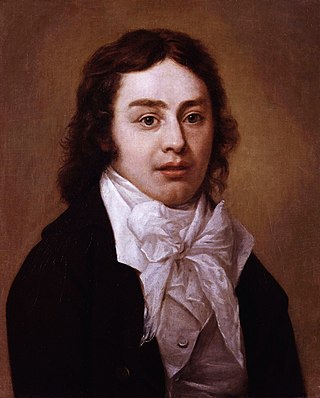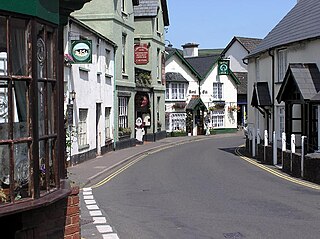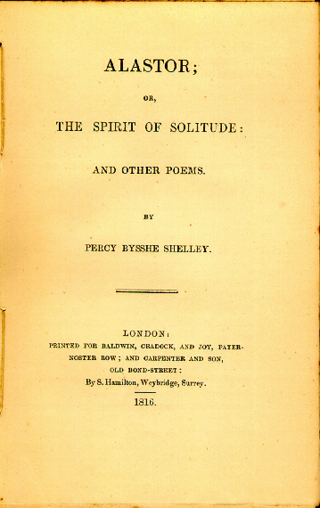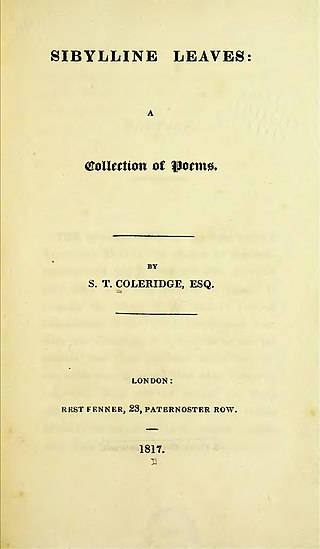
Kubla Khan: or A Vision in a Dream is a poem written by Samuel Taylor Coleridge, completed in 1797 and published in 1816. It is sometimes given the subtitles "A Vision in a Dream" and "A Fragment." According to Coleridge's preface to Kubla Khan, the poem was composed one night after he experienced an opium-influenced dream after reading a work describing Shangdu, the summer capital of the Mongol-led Yuan dynasty of China founded by Kublai Khan. Upon waking, he set about writing lines of poetry that came to him from the dream until he was interrupted by "a person on business from Porlock". The poem could not be completed according to its original 200–300 line plan as the interruption caused him to forget the lines. He left it unpublished and kept it for private readings for his friends until 1816 when, at the prompting of Lord Byron, it was published.

Samuel Taylor Coleridge was an English poet, literary critic, philosopher, and theologian who, with his friend William Wordsworth, was a founder of the Romantic Movement in England and a member of the Lake Poets. He also shared volumes and collaborated with Charles Lamb, Robert Southey, and Charles Lloyd.

William Wordsworth was an English Romantic poet who, with Samuel Taylor Coleridge, helped to launch the Romantic Age in English literature with their joint publication Lyrical Ballads (1798).

The Rime of the Ancient Mariner is the longest major poem by the English poet Samuel Taylor Coleridge, written in 1797–98 and published in 1798 in the first edition of Lyrical Ballads. Some modern editions use a revised version printed in 1817 that featured a gloss. Along with other poems in Lyrical Ballads, it is often considered a signal shift to modern poetry and the beginning of British Romantic literature.

The "person on business from Porlock" was an unwelcome visitor to Samuel Taylor Coleridge during his composition of the poem Kubla Khan in 1797. Coleridge claimed to have perceived the entire course of the poem in a dream, but was interrupted by this visitor who came "on business from Porlock" while in the process of writing it. Kubla Khan, only 54 lines long, was never completed. Thus "person from Porlock", "man from Porlock", or just "Porlock" are literary allusions to unwanted intruders who disrupt inspired creativity.

Ernest Hartley Coleridge (1846–1920) was a British literary scholar and poet. He was the son of Derwent Coleridge and grandson of Samuel Taylor Coleridge.

Alastor, or The Spirit of Solitude is a poem by Percy Bysshe Shelley, written from 10 September to 14 December in 1815 in Bishopsgate, near Windsor Great Park and first published in 1816. The poem was without a title when Shelley passed it along to his contemporary and friend Thomas Love Peacock. The poem is 720 lines long. It is considered to be one of the first of Shelley's major poems.

Coleridge Cottage is a cottage situated in Nether Stowey, Bridgwater, Somerset, England. It is a grade II* listed building. The 17th century cottage was originally two buildings which were later combined and expanded.
Nationality words link to articles with information on the nation's poetry or literature.
Nationality words link to articles with information on the nation's poetry or literature.

Samuel Taylor Coleridge was an English poet, critic, and philosopher who consumed opium to address his health issues. His use of opium in his home country of England, as well as Sicily and Malta, is extensively documented. Coleridge's opium use led to severe consequences. Coupled with his health conditions, it harmed his life and adversely impacted his career.

The Lucy poems are a series of five poems composed by the English Romantic poet William Wordsworth (1770–1850) between 1798 and 1801. All but one were first published during 1800 in the second edition of Lyrical Ballads, a collaboration between Wordsworth and Samuel Taylor Coleridge that was both Wordsworth's first major publication and a milestone in the early English Romantic movement. In the series, Wordsworth sought to write unaffected English verse infused with abstract ideals of beauty, nature, love, longing, and death.
The Nightingale: A Conversation Poem is a poem written by Samuel Taylor Coleridge in April 1798. Originally included in the first edition of Lyrical Ballads, which he published with William Wordsworth, the poem disputes the traditional idea that nightingales are connected to the idea of melancholy. Instead, the nightingale represents to Coleridge the experience of nature. Midway through the poem, the narrator stops discussing the nightingale in order to describe a mysterious female and a gothic scene. After the narrator is returned to his original train of thought by the nightingale's song, he recalls a moment when he took his crying son out to see the Moon, which immediately filled the child with joy. Critics have found the poem either decent with little complaint or as one of his better poems containing beautiful lines.
Christabel is a 2001 avant-garde experimental film directed by James Fotopoulos and based on the unfinished poem of the same name by Samuel Taylor Coleridge.
Hymn Before Sunrise is a poem written by Samuel Taylor Coleridge in 1802. Originally published in The Morning Post, it describes feelings that Coleridge claimed to have experienced on his own. However, it was later revealed that parts of the poem were heavily influenced by a poem by Friederike Brun, which led to criticism against Coleridge for not acknowledging his sources. Aspects of the poem did have direct origin in Coleridge's own life and experiences, and the work represents one of the last times a poem captured his feelings of joy during that period of his life.
"A slumber did my spirit seal" is a poem that was written by William Wordsworth in 1798 and first published in volume II of the 1800 edition of Lyrical Ballads. It is part of a series of poems written about a mysterious woman named Lucy, whom scholars have not been able to identify and are not sure whether she was real or fictional. Although the name Lucy is not directly mentioned in the poem, scholars nevertheless believe it to be part of the "Lucy poems" due to the poem's placement in Lyrical Ballads.

The White Doe of Rylstone; or, The Fate of the Nortons is a long narrative poem by William Wordsworth, written initially in 1807–08, but not finally revised and published until 1815. It is set during the Rising of the North in 1569 and combines historical and legendary subject-matter. It has attracted praise from some critics, but has never been one of Wordsworth's more popular poems.

Romanticism was an artistic, literary, and intellectual movement that originated in Europe toward the end of the 18th century. Scholars regard the publishing of William Wordsworth's and Samuel Coleridge's Lyrical Ballads in 1798 as probably the beginning of the movement in England, and the crowning of Queen Victoria in 1837 as its end. Romanticism arrived in other parts of the English-speaking world later; in the United States, about 1820.

Sibylline Leaves: A Collection of Poems is a volume of poems by Samuel Taylor Coleridge, first published in 1817.
Love is a poem by Samuel Taylor Coleridge, first published in 1799 as Introduction to the Tale of the Dark Ladie.
















